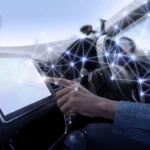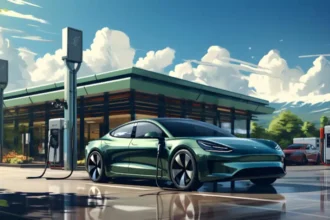Have you ever imagined a world where your vehicle’s license plate does more than just display numbers and letters? A world where your license plate is a dynamic display of information, seamlessly integrating with the digital age? Welcome to the future of digital license plates. This technological advancement promises to revolutionize vehicle identification and registration, offering a plethora of benefits that go beyond mere aesthetics.
Introduction: What Are Digital License Plates?
Digital license plates, often referred to as electronic or e-plates, are digital displays that replace the traditional metal and plastic license plates. These plates use electronic paper (e-paper) or similar display technology to show the license number and other relevant information. The idea is to create a smarter, more efficient system for vehicle identification and registration.
Primary Keywords
- Digital license plates
- Vehicle identification
- License plate technology
- Digital plates benefits
- DMV automation
The Evolution of License Plates
A Brief History
License plates have been around since the early 1900s, primarily serving as a means of vehicle identification. Over the years, they have evolved in design, materials, and security features, but the fundamental concept has remained unchanged.
The Need for Change
In today’s digital age, almost every aspect of our lives is influenced by technology. The automotive industry, particularly in areas such as autonomous vehicles and smart transportation systems, is no exception. Digital license plates represent the next logical step in this evolution, offering numerous advantages over traditional plates.
How Do Digital License Plates Work
Technology Behind Digital Plates
Digital license plates utilize advanced technologies such as e-paper, similar to what you find in e-readers like the Kindle. This technology allows for clear visibility in various lighting conditions while consuming minimal power.
Integration with Vehicle Systems
These plates are integrated with the vehicle’s onboard systems and can communicate with the Department of Motor Vehicles (DMV) and other relevant authorities in real-time. This connectivity allows for dynamic updates and enhanced security features.
Benefits of Digital License Plates
Enhanced Security
One of the most significant advantages of digital license plates is enhanced security. These plates can be programmed to display specific messages in case of theft or other emergencies. For instance, if a car is reported stolen, the plate can flash “Stolen Vehicle” to alert authorities and the public.
DMV Automation and Efficiency
Digital plates streamline DMV processes by enabling automatic updates and renewals. This automation reduces the need for physical visits to the DMV, saving time and resources for both the DMV and vehicle owners.
Customization and Personalization
Digital plates can be customized to display messages or graphics. This feature can be used for advertising, special events, or personal messages, adding a new dimension to vehicle personalization.
Environmental Impact
By reducing the need for physical materials and the associated manufacturing processes, digital plates can contribute to environmental sustainability. This shift aligns with broader efforts to reduce the automotive industry’s carbon footprint.
Real-Time Information Display
These plates can display real-time information, such as registration status, toll payments, and parking permits. This dynamic display capability enhances convenience and ensures compliance with regulations.
Table: Traditional vs. Digital License Plates
| Feature | Traditional Plates | Digital Plates |
|---|---|---|
| Material | Metal/Plastic | E-Paper/LED |
| Information Display | Static | Dynamic |
| Security Features | Basic | Advanced (e.g., Theft Alerts) |
| DMV Integration | Manual | Automated |
| Environmental Impact | Higher | Lower |
| Customization | Limited | Extensive |
| Real-Time Updates | No | Yes |
Potential Challenges and Concerns
Cost and Accessibility
The initial cost of digital license plates is higher compared to traditional plates. Ensuring that this technology is accessible and affordable for all vehicle owners is a crucial consideration.
Privacy Issues
With enhanced tracking and real-time data transmission, privacy concerns arise. Ensuring robust data protection measures and transparent policies is essential to address these concerns.
Reliability and Durability
Digital plates must withstand various weather conditions and physical impacts. Ensuring their reliability and durability is critical for widespread adoption.
The Future Landscape: What to Expect
Adoption by States and Countries
Several states in the USA, such as California and Arizona, have already started pilot programs for digital license plates. As the technology proves its viability, more states and countries are likely to follow suit.
Integration with Smart Cities
Digital license plates will play a crucial role in the development of smart cities. They can facilitate better traffic management, improved law enforcement, and enhanced public safety.
Innovations on the Horizon
Future innovations may include advanced features like GPS tracking, integration with vehicle diagnostics, and even blockchain technology for secure data handling.
Frequently Asked Questions (FAQs)
What are digital license plates?
Digital license plates are electronic displays that replace traditional metal or plastic plates, offering dynamic information display and enhanced features.
How do digital license plates improve security?
They can display real-time messages such as “Stolen Vehicle” and integrate with law enforcement systems for quicker response and recovery.
Are digital license plates legal?
Yes, several states have legalized digital license plates, and pilot programs are underway in various regions.
What are the costs associated with digital license plates?
While the initial cost is higher than traditional plates, the long-term benefits, such as reduced DMV visits and enhanced security, can offset these costs.
How do digital license plates impact privacy?
Digital plates involve real-time data transmission, raising privacy concerns. It’s essential to have robust data protection measures in place.
Can digital license plates withstand harsh weather conditions?
Yes, they are designed to be durable and reliable under various environmental conditions.
READ MORE : Car Technology Trends to Watch in the Next 5 Years
Conclusion: Embrace the Future of Vehicle Identification
The future of digital license plates is promising, offering numerous benefits from enhanced security to environmental sustainability. As this technology evolves and becomes more accessible, it will revolutionize how we approach vehicle identification and registration.
Thank you for reading! To stay updated on the latest trends and advancements in digital license plate technology and other automotive innovations, join our community through social media, push notifications, and newsletters. Together, let’s drive into the future!











